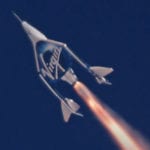 Movies and TV
Movies and TV  Movies and TV
Movies and TV  History
History 10 Things You Didn’t Know About the American National Anthem
 Technology
Technology Top 10 Everyday Tech Buzzwords That Hide a Darker Past
 Humans
Humans 10 Everyday Human Behaviors That Are Actually Survival Instincts
 Animals
Animals 10 Animals That Humiliated and Harmed Historical Leaders
 History
History 10 Most Influential Protests in Modern History
 Creepy
Creepy 10 More Representations of Death from Myth, Legend, and Folktale
 Technology
Technology 10 Scientific Breakthroughs of 2025 That’ll Change Everything
 Our World
Our World 10 Ways Icelandic Culture Makes Other Countries Look Boring
 Misconceptions
Misconceptions 10 Common Misconceptions About the Victorian Era
 Movies and TV
Movies and TV The 10 Coolest Stars to Set Sail on The Love Boat
 History
History 10 Things You Didn’t Know About the American National Anthem
 Technology
Technology Top 10 Everyday Tech Buzzwords That Hide a Darker Past
Who's Behind Listverse?

Jamie Frater
Head Editor
Jamie founded Listverse due to an insatiable desire to share fascinating, obscure, and bizarre facts. He has been a guest speaker on numerous national radio and television stations and is a five time published author.
More About Us Humans
Humans 10 Everyday Human Behaviors That Are Actually Survival Instincts
 Animals
Animals 10 Animals That Humiliated and Harmed Historical Leaders
 History
History 10 Most Influential Protests in Modern History
 Creepy
Creepy 10 More Representations of Death from Myth, Legend, and Folktale
 Technology
Technology 10 Scientific Breakthroughs of 2025 That’ll Change Everything
 Our World
Our World 10 Ways Icelandic Culture Makes Other Countries Look Boring
 Misconceptions
Misconceptions 10 Common Misconceptions About the Victorian Era
10 Amazing And Disgusting Butts That Serve An Incredible Purpose
Most of us probably don’t think too much about the rear ends of our nonhuman cousins, but it’s about time we did because there are some extremely odd and oftentimes useful backsides in the animal kingdom! While ours is more for sitting than anything else (debatable, I know), many animals have evolved their rear ends to be useful tools, defensive weaponry, and, of course, romantic enticements. Here are 10 of the most amazing and disgusting butts in the animal kingdom that serve an incredible purpose.
10 Baboons
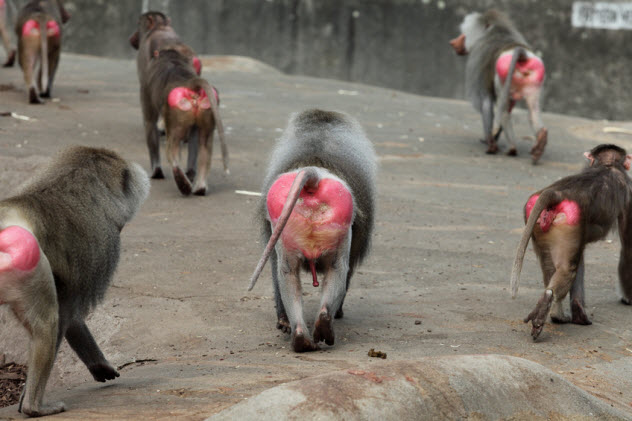
Remember going to the zoo for the first time and asking why the baboon’s butt looked so incredibly weird compared to . . . well, every other animal in the zoo? Although it certainly is an odd backside, the baboon has evolved its rear end to serve a very specific purpose: female baboons’ rear ends swell up to magnificent proportions when they are sexually receptive.
This has become a contest of sorts where the females in a group will essentially compete with one another for the males’ attention. Male baboons recognize the enlarged bottoms of their female counterparts and go for the biggest and the best. The process of increasing the size of their rear is energy intensive as it adds a considerable amount of body weight—often as much as 14 percent.
When a female is ready to mate, which is approximately every 37 days, she will present her rump to her potential suitors. Baboons are generally very promiscuous, so they will mate with multiple males throughout their period of “courtship.” Interestingly, the size and color of the female’s posterior does not necessarily indicate a more fertile mate. Research has shown that male baboons, while certainly attracted to those beautiful red rear ends, tend to target females who have had more ovulation cycles or several cycles since last birthing offspring.
9 Wombats
The wombat is an interesting animal like many that live “down under.” It is the largest mammal that lives underground, and this is for an interesting reason, much to do with its butt! The wombat has developed an incredibly tough backside that is filled with cartilage, which makes it into a sort of armored rear end. It uses this hardened posterior to its advantage by blocking its burrow to protect itself from predators.
Wombats aren’t the fastest animals in the world, and they need a way to keep themselves and their offspring safe. You might be concerned that its exposed buttocks, though tough compared to the rest of its body, might be a problem when it comes to the wombat’s tail. But you need not concern yourself because its tail is only 2 centimeters (1 in) long.
Although the wombat’s butt is primarily used for defense, this animal is capable of using its buttocks as a powerful weapon. When chased into its burrow, the wombat can use its butt to smash the skull of its pursuer into the walls or roof of its burrow. This includes predators such as the Tasmanian devil and dingoes.
8 Skipper Caterpillars
When most people picture caterpillars, they might skip the crawling fellows altogether and think only of butterflies. After all, they tend to be the more attractive versions of the little buggers. The skipper caterpillar might make you look twice . . . or perhaps look away very quickly due to its butt-enabled defensive mechanism known as scat firing. For those of you not familiar with the term, scat is a polite word for describing animal feces (poop).
When threatened, the skipper caterpillar is able to launch its poop to discourage an attack that might make it a tasty meal for a bird or a confused human. Not only can it fire its poop away from itself, it can do it up to 40 times its body length at a speed of up to 1.3 meters per second (4.3 ft/sec). For a 183-centimeter-tall (6 ft) human, the equivalent distance would be around 75 meters (240 ft).
Not only is this an amazing feat of genetic evolution, but the way that it works is quite interesting as well. The caterpillar’s poop comes out in the form of small pellets, which it stores under a special anal “launching pad.” It pumps up its blood pressure directly below this tissue and fires its poop in pretty much the same way that a catapult fires a boulder.
Scientists used to believe that this mechanism was used solely for good housekeeping. It allowed the caterpillar’s home to remain free of feces while the caterpillar enjoyed a carefree lifestyle of eating leaves and metamorphosing into a rather interesting butterfly.
As it turns out, the poop flicking is remarkably good at deterring the caterpillar’s main predator, the paper wasp. The wasps are attracted to the odor of the poop, which suggests that the reason to keep the caterpillar’s house clean is actually to camouflage themselves outside of the smell of their own feces.
7 Pygmy Sperm Whales

There are two terms that you never want to encounter while swimming in the ocean near a pygmy sperm whale: “defense mechanism” and “anal syrup.” Actually, putting the words “anal” and “syrup” together makes for a pretty nasty encounter.
The pygmy sperm whale is pretty much what it sounds like, a smaller species of the sperm whale. Most whales are able to deter predators simply by showing up since their size makes them unlikely candidates for the occasional attack. The pygmy sperm whale decided on a different route and stayed at a maximum size of approximately 3.5 meters (11 ft).
Needing to come up with a method to keep itself safe, the pygmy sperm whale decided on a bladder at the end of its intestines that contains around 11 liters (3 gal) of the aforementioned anal syrup. When threatened, the whale will violently secrete this cloud of reddish-brown goo and swoosh it around with its tail to make a large cloud of the noxious fluid.
Unsurprisingly, this deters predators and allows the whale to escape its attacker. This method is similar to the ink spray that an octopus or a squid might use to keep itself safe from predators. It is only seen in this small class of whales.
6 Dragonfly Nymphs
The immature dragonfly begins its life as an underwater nymph (similar to a mosquito). Unlike its bloodsucking cousin, though, the dragonfly has an interesting adaptation in the form of its butt.
To swim, the dragonfly nymph forces a jet of water from its anus and shoots itself forward. It also breathes out of the same anus using specially adapted gills inside. Although that is all very interesting, its most amazing feature is that it cannot eat without its butt! Its labium (mouth-grabber) is hydraulically activated.
After taking in water through its anus, the dragonfly clenches, compressing its abdominal and thoracic muscles against the water-laden rectal chamber. This increases the pressure in the dragonfly’s internal body cavity and pushes out its jaws. Then the mouth-grabber shoots out at an incredibly fast speed with up to 1 pound of pressure, which might not seem like a lot until you consider that these little guys are only 1–3 centimeters (0.5–1.5 in) long.
5 Manatees
At first glance, you might judge the manatee’s anus to be relatively normal, and by all accounts of marine mammals, it is. Of course, this adorable animal, which is often called a sea cow, is hiding a secret. The manatee has evolved to have one of the most muscular and strangest diaphragms of any mammal—and for good reason. It needs to be able to hold onto and eventually release gas as a means of maintaining buoyancy.
Basically, the manatee farts a large amount of held-in gas so that it can dive deeper or raise itself to the surface. Think about the way you swim deeper by letting air out of your lungs. This is essentially the same thing, only the manatee prefers to push its air right out of its butt.
This ability is unique to this lumbering marine mammal as most other marine mammals have collapsible lungs and blowholes, which allow them to regulate their buoyancy and deal with increases in pressure. The manatee went a completely different route and decided that it would be best to fart its way through the Earth’s rivers and oceans as it slowly and happily moves about.
Fortunately for those so inclined, the Internet is chock full of this very phenomenon. If you would like to see and hear a manatee fart for yourself, check out the video above.
4 Sea Cucumbers
Most people who have seen a sea cucumber would not think that it was a vicious attacker or had an interesting anus. But it most certainly does. Sea cucumbers have an interesting ability to defend themselves from would-be attackers.
They are able to contract their bodies in such a way that they eject their internal organs out of their anuses onto predators—in many cases, entangling those predators! Not only is this both disgusting and amazing but some of the organs are toxic. They contain a toxin called holothurin, which can be fatal to many different species of fish.
This process is called evisceration, which literally means the removal of viscera (internal organs), or disembowelment. You might be asking yourself, “Doesn’t the sea cucumber need these organs?” Fortunately for our disgusting friends on the bottom of the ocean, they are able to fully regenerate almost any internal organ thrown toward their attackers in as little as 6 to 10 weeks.
3 Chinese Yellow Swallowtails (Butterflies)
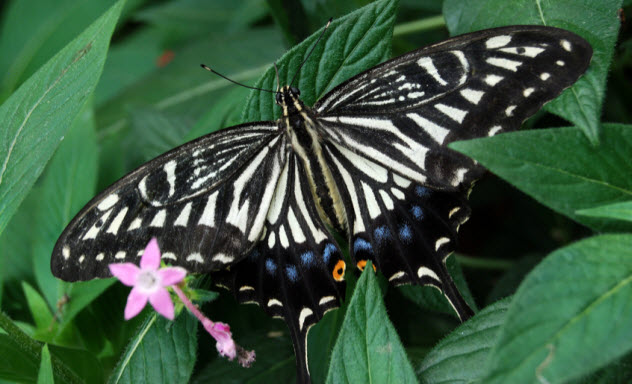
Most people would probably agree that one of the worst places to put an ability to “see” is on one’s rear end. It seems that the Chinese yellow swallowtail did not receive this memo and has developed two very interesting photoreceptors right at the tip of its bum.
While not eyes in the traditional sense, these photoreceptors are capable of taking in light and identifying various things so that the butterfly might better mate and deposit its eggs. The process of light detection used by the butterfly is called chromatic contrast.
One of the main purposes for this ability is to help the males and females that engage in coitus to align their genitals properly. Apparently, this was somewhat difficult at first, so the butterflies evolved a couple of rudimentary eyes for this purpose.
This is not without good reason and is mostly due to the environment in which the butterflies mate. As they mate only in sunshine, the photoreceptors on their rear ends allow them to detect contrast changes, mostly in the blue color spectrum so that they can differentiate their potential mates from just about anything else. The male and female are able to accurately align their genitalia and . . . well, you know the rest.
2 Fitzroy River Turtles
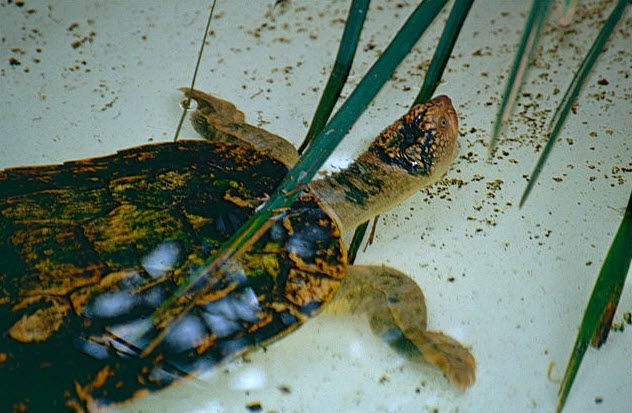
Although most species of turtles use their nostrils for the intake of air, the Australian Fitzroy River turtle has evolved to breathe out of its anus. Most people learning this fact might have one simple question, “Why?”
There is a very good reason that this little turtle, which is vulnerable and now protected, has learned to breathe out of its butt. It enables the turtle to stay underwater for far longer than any of its turtle cousins, making the Fitzroy River turtle both less susceptible to predation and better able to feed itself.
The turtle has a specially adapted cloaca (similar to an anus) that allows for the intake of oxygen through the water. It can extract up to 41 percent of the oxygen in water and store it for use in respiration. This allows the turtle to stay underwater for up to three weeks without having to take in any air through its nostrils like all other turtles.
This ability has earned this small, endangered turtle the nickname of “bum breather.” Other species of turtles have similar cloacae that allow them to take in a small amount of aquatic oxygen for use in respiration, but those levels rarely exceed 4 percent, making the Fitzroy River turtle truly unique.
1 Ravine Trapdoor Spiders
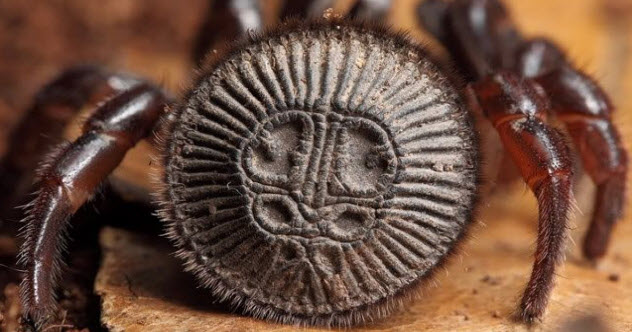
Few animals have had evolution devise as useful a rear as the trapdoor spider. Most examples of this species hunt by digging a small hole with a hinged trapdoor that they hide under. When some unsuspecting prey strolls by, the spider quickly strikes from its burrow and takes in its food. Some species of the spider that fall under the Cyclocosmia genus have evolved in such a way that they don’t require a hinged trapdoor at all.
In what is primarily a defensive technique, the spider will clog the doorway of its burrow with its rear, which is a hardened disk strengthened by a series of ribs and grooves. It also uses this unique feature to make its burrow look innocuous to any unsuspecting prey that might come along.
As the spider will plug its hole whenever it feels threatened, the unique abdomen is almost all you will see of this spider in the wild. The hardened disk likely evolved specifically to defend itself from predatory wasps, which might otherwise be able to sting and pull the spider from its burrow.
+ Giraffes
While not exactly an evolutionary adaptation that makes their butts extremely useful, giraffes have found a way to use their rear ends for reasons other than you might think. Giraffes twist themselves into what looks like an extremely uncomfortable position and use their butts as pillows, which answers the question of why giraffes evolved such long necks. (I bet you thought it was to eat leaves from high branches!)
Giraffes are especially interesting when it comes to their sleep patterns. Not only do they routinely lay their heads down on the same instrument they use for pooping but they also sleep less than any mammal in the animal kingdom. Giraffes have been observed to require only 30 minutes of sleep in a 24-hour period.
They achieve this by taking short, intense power naps of about five minutes each. It is thought that they do this to avoid predation. Supposedly, this makes them less likely targets of attack because they are constantly on the move instead of lying about all night like most mammals have the sense to do.
Jonathan is an amateur graphic artist, illustrator, and game designer with a few independently published games through his game company, TalkingBull Games. He enjoys researching and writing about history, science, theology, and many other subjects.
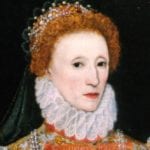

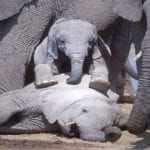
![Top 10 Disgusting Foods The Chinese Eat [DISTURBING] Top 10 Disgusting Foods The Chinese Eat [DISTURBING]](https://listverse.com/wp-content/uploads/2020/03/23773182-0-image-a-46_1580303417295-150x150.jpg)




